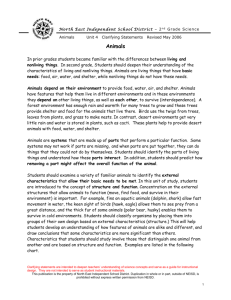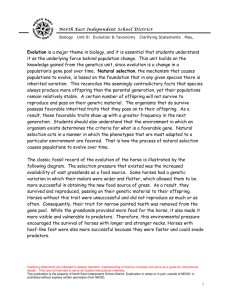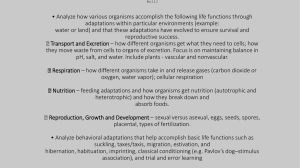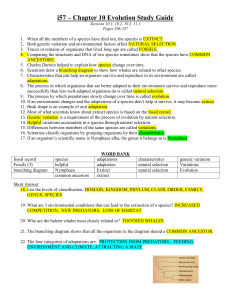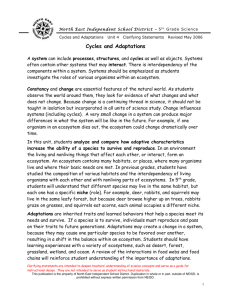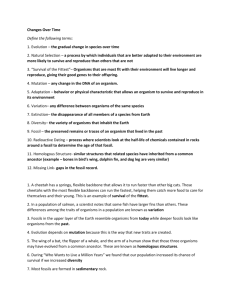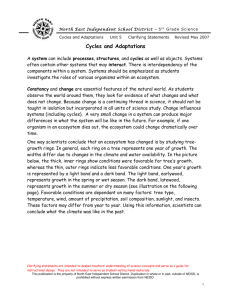Living Systems and Adaptations - North East Independent School
advertisement
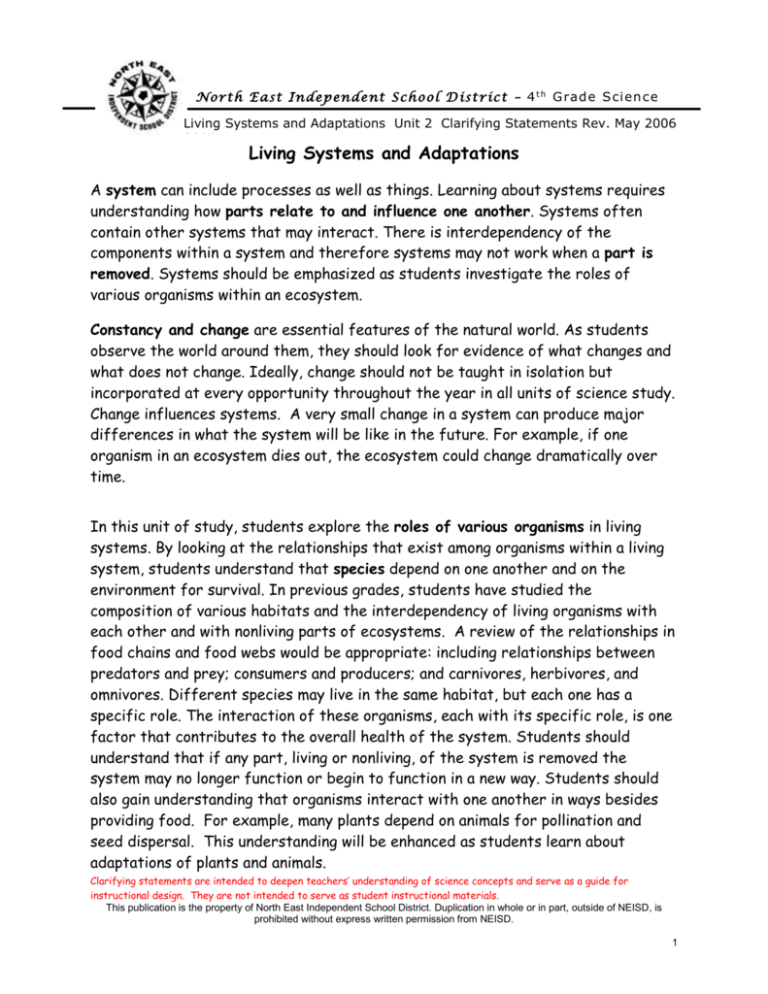
N o r t h E a st I n d ep en d e nt S c h o o l D i st ric t – 4 t h G rad e S ci en c e Living Systems and Adaptations Unit 2 Clarifying Statements Rev. May 2006 2006 Living Systems and Adaptations A system can include processes as well as things. Learning about systems requires understanding how parts relate to and influence one another. Systems often contain other systems that may interact. There is interdependency of the components within a system and therefore systems may not work when a part is removed. Systems should be emphasized as students investigate the roles of various organisms within an ecosystem. Constancy and change are essential features of the natural world. As students observe the world around them, they should look for evidence of what changes and what does not change. Ideally, change should not be taught in isolation but incorporated at every opportunity throughout the year in all units of science study. Change influences systems. A very small change in a system can produce major differences in what the system will be like in the future. For example, if one organism in an ecosystem dies out, the ecosystem could change dramatically over time. In this unit of study, students explore the roles of various organisms in living systems. By looking at the relationships that exist among organisms within a living system, students understand that species depend on one another and on the environment for survival. In previous grades, students have studied the composition of various habitats and the interdependency of living organisms with each other and with nonliving parts of ecosystems. A review of the relationships in food chains and food webs would be appropriate: including relationships between predators and prey; consumers and producers; and carnivores, herbivores, and omnivores. Different species may live in the same habitat, but each one has a specific role. The interaction of these organisms, each with its specific role, is one factor that contributes to the overall health of the system. Students should understand that if any part, living or nonliving, of the system is removed the system may no longer function or begin to function in a new way. Students should also gain understanding that organisms interact with one another in ways besides providing food. For example, many plants depend on animals for pollination and seed dispersal. This understanding will be enhanced as students learn about adaptations of plants and animals. Clarifying statements are intended to deepen teachers’ understanding of science concepts and serve as a guide for instructional design. They are not intended to serve as student instructional materials. This publication is the property of North East Independent School District. Duplication in whole or in part, outside of NEISD, is prohibited without express written permission from NEISD. 1 N o r t h E a st I n d ep en d e nt S c h o o l D i st ric t – 4 t h G rad e S ci en c e Living Systems and Adaptations Unit 2 Clarifying Statements Rev. May 2006 2006 Students should also understand that the source of energy in almost all ecosystems is the Sun. (An exception is an ecosystem around a deep ocean vent, which does not depend on the Sun for energy). Almost all food webs begin with producers (plants). Plants capture light energy from the sun and use it to manufacture food (sugars) from carbon dioxide and water through a process called photosynthesis. Plants use the energy from this food to live and grow. Energy is passed through an ecosystem as other organisms eat the plants, and predators in turn eat them. The arrows in a food web or food chain should always show the flow of energy through a system. They should point from the organism being consumed to the organism doing the consuming. Example of a simple food chain with arrows showing energy flow Organisms have two main types of traits: those that are inherited and those that are learned. Inherited traits are passed from parents to offspring. Through observation of actual organisms, pictures, or videos, students should notice that offspring generally look like their parents. These traits include things such as fur color, leaf shape, or number of legs. Some types of behaviors are also inherited. These behaviors are called instincts, and organisms are born knowing how to do them. For example, some birds are born knowing that they must migrate at various seasons of the year. Other types of behaviors are learned. For example, a child is not born knowing how to play baseball. Through observation and practice he or she learns the rules and skills of the game. Animals also learn behaviors. These learned behaviors usually help them survive and are the result of living and non-living environmental Clarifying statements are intended to deepen teachers’ understanding of science concepts and serve as a guide for instructional design. They are not intended to serve as student instructional materials. This publication is the property of North East Independent School District. Duplication in whole or in part, outside of NEISD, is prohibited without express written permission from NEISD. 2 N o r t h E a st I n d ep en d e nt S c h o o l D i st ric t – 4 t h G rad e S ci en c e Living Systems and Adaptations Unit 2 Clarifying Statements Rev. May 2006 2006 influences. For example, a bird learns to avoid eating monarch butterflies by eating one and becoming sick. Unlike animals, plants cannot learn. Students should keep lists of things that animals and plants get from their parents and things that are learned in order to distinguish between the two. Inherited Learned The color of your eyes Writing your name A turtle's shell A cow runs at the sound of a rattle snake A flower's color A tree growing an apple Fish come to the top of the bowl when you feed them When the fire alarm sounds, we exit the building Leaves dropping from the tree in the fall Your dog sits on command Brown fur color Brushing your teeth Feathers as a body covering Wrapping a package In animals, traits acquired after birth are not passed on from parents to offspring through heredity. For example, a dog that loses a leg due to an injury would not have puppies without a leg. Some acquired plant traits are the result of human manipulation. For example, a man may trim the bush in his yard to be a certain shape, but without repeated trimming the plant would not keep this shape nor would new plants have the trimmed shape. Other acquired traits may be due to environmental influences. For example, trees can be bent by the wind, but their offspring will not necessarily have the same shape if they are planted in a different location. If a species is to survive, individuals must reproduce and pass on their traits to future generations. Adaptations are inherited traits that help a species meet its needs and survive. The concept of adaptation and survival is focused at the species Clarifying statements are intended to deepen teachers’ understanding of science concepts and serve as a guide for instructional design. They are not intended to serve as student instructional materials. This publication is the property of North East Independent School District. Duplication in whole or in part, outside of NEISD, is prohibited without express written permission from NEISD. 3 N o r t h E a st I n d ep en d e nt S c h o o l D i st ric t – 4 t h G rad e S ci en c e Living Systems and Adaptations Unit 2 Clarifying Statements Rev. May 2006 2006 Living Systems and Adaptations (cont’d) level rather than on individual organisms. A species is adapted to its environment when an inherited trait helps the species survive there. For example, a snowshoe hare is white in the winter and brown in the summer. This adaptation helps this species survive in its seasonally changing environment. Adaptations may cause a system to change because they may increase the survival of one particular species over another, causing the balance in the system to shift. Changes in the environment may cause the natural variation in organisms to become an advantage. For example, jackrabbits live in a sandy, rocky habitat with some dry grasses. A jackrabbit may have several babies, five brown and one white. The baby rabbits with brown fur will blend in with their habitat very well and will be more likely to survive. The white baby rabbit will be more easily seen by a hungry fox and probably will not survive to pass on white fur to any offspring. Over time there may be significantly more brown jackrabbits in this habitat. However, if the habitat and climate were to change and become snow covered, the trend would be reversed. The white baby rabbits would now have the advantage and be able to survive better because the hungry fox would notice the brown baby rabbits more easily. The number of white rabbits would increase and the number of brown rabbits would decrease. This could lead to a change in the species, after many generations that would include almost all white rabbits. Some inherited traits only become noticeable when triggered by environmental changes. For example, a wolf will develop a thicker coat in the winter that helps protect it better from the cold temperature than its thinner summer coat would. Also, most trees have root systems that respond to available water. These trees may develop deeper root systems to reach a water source. These changes are inherited abilities that are triggered by the environment in which the organisms live. Students should identify adaptations in a variety of species of both plants and animals. By comparing the adaptations of various species, students can develop generalizations about the kinds of adaptations predators have (offensive tools Clarifying statements are intended to deepen teachers’ understanding of science concepts and serve as a guide for instructional design. They are not intended to serve as student instructional materials. This publication is the property of North East Independent School District. Duplication in whole or in part, outside of NEISD, is prohibited without express written permission from NEISD. 4 N o r t h E a st I n d ep en d e nt S c h o o l D i st ric t – 4 t h G rad e S ci en c e Living Systems and Adaptations Unit 2 Clarifying Statements Rev. May 2006 2006 Living Systems and Adaptations (cont’d) such as teeth, beaks, claws, venom, etc.) and those that prey have (defensive tools such as camouflage to hide, speed to escape, shields or spines to ward off, irritating smells to repel, etc.). This comparison could also lead students to understand that animals are placed into groups based on their similarities and differences. Some Types of Adaptations Purpose of the Adaptation Examples Getting Food Protection Eagles have sharp beaks that they use to tear apart small animals. Female mosquitoes use their straw-like mouthparts to suck blood. Rosebushes have thorns that help protect them from planteating animals. When skunks are threatened, they can spray a bad-smelling liquid onto their enemies. The seeds of coconut palm trees float on water and can be carried from one island to another by the ocean. Reproduction Water Conservation Lizards have scaly skin that prevents water loss. Some plants have small leaves to prevent water loss. Fish have gills that they use to take oxygen from the water in which they live. A whale breathes air through a single nostril on top of its head when it comes to the ocean’s surface. Getting Oxygen These groups have adaptations in common and show the great diversity of life that is able to survive on Earth. Students were introduced to the idea of scientific Clarifying statements are intended to deepen teachers’ understanding of science concepts and serve as a guide for instructional design. They are not intended to serve as student instructional materials. This publication is the property of North East Independent School District. Duplication in whole or in part, outside of NEISD, is prohibited without express written permission from NEISD. 5 N o r t h E a st I n d ep en d e nt S c h o o l D i st ric t – 4 t h G rad e S ci en c e Living Systems and Adaptations Unit 2 Clarifying Statements Rev. May 2006 2006 classification, at a very fundamental level, in second grade as they looked at the external characteristics and their functions of various animals and plants. In fourth grade it would be appropriate for students to extend their knowledge of these groups. The chart below includes the characteristics that these groups have in common. Students should focus on the commonalities, rather than memorizing the names of these groups. A more in depth classification (i.e. Kingdom, Phylum, or Species) is not appropriate at the elementary level. Characteristics (adaptations) Fur or hair Warm-blooded Live birth Nurse and care for their young Breathe through lungs Feathers Warm-blooded Hatch from eggs Breathe through lungs Scales and dry, thick skin Cold-blooded Breathe through lungs Most hatch from eggs Scales Cold-blooded Gills to breathe in water Most lay eggs, a few snakes have live birth Moist, thin skin Begin life in water with gills Develop lungs as an adult Adapted to live on land and in water Cold-blooded Hatch from eggs Vertebrate Group Mammals Birds Reptiles Fish Amphibians Examples Bear Elephant Whale Dog Eagle Hawk Woodpecker Vulture Turtle Snake Lizard Crocodile Goldfish Catfish Tuna Salmon Frog Salamander Newt Toad Clarifying statements are intended to deepen teachers’ understanding of science concepts and serve as a guide for instructional design. They are not intended to serve as student instructional materials. This publication is the property of North East Independent School District. Duplication in whole or in part, outside of NEISD, is prohibited without express written permission from NEISD. 6 N o r t h E a st I n d ep en d e nt S c h o o l D i st ric t – 4 t h G rad e S ci en c e Living Systems and Adaptations Unit 2 Clarifying Statements Rev. May 2006 2006 Students should also understand the major adaptations of plants that scientists use to classify them into groups. A diagram follows to outline these commonalities. Plants Non-seed Plants (Spores) Mosses Ferns Seed Plants (Seeds) Flowering Plants Conifers Most organisms change in several ways throughout their life cycle. Some organisms are born looking like a smaller version of the adult they will become, and their outward appearance changes very little as they grow. A grasshopper is an example of this type of organism. Other organisms have major changes in body form as they go through their life cycle. This is called metamorphosis. Butterflies are an example of organisms that go through this dramatic set of changes: egg, larva, pupa, and adult. A frog changing from a tadpole with gills to an adult frog with lungs is another example of this type of change. All of these processes are one more amazing way for students to understand the diverse ways organisms are adapted to survive on Earth. Clarifying statements are intended to deepen teachers’ understanding of science concepts and serve as a guide for instructional design. They are not intended to serve as student instructional materials. This publication is the property of North East Independent School District. Duplication in whole or in part, outside of NEISD, is prohibited without express written permission from NEISD. 7 N o r t h E a st I n d ep en d e nt S c h o o l D i st ric t – 4 t h G rad e S ci en c e Living Systems and Adaptations Unit 2 Clarifying Statements Rev. May 2006 2006 Note: Many campuses use the Constancy and Change Vistas, which contain lessons on either lifecycles or adaptations. The Vistas suggest the following organisms (focus is indicated in parenthesis): Kindergarten – Ladybugs (life cycle) 3rd Grade – Frogs (adaptations) 1st Grade – Mealworms (life cycle) 4th Grade – Bats (adaptations) 2nd Grade – Butterflies (life cycle) 5th Grade – Brown Pelican (adaptations) Dissections are not recommended for elementary students. Fossil records help scientists know about the relationship between species of the past with those of the present. Fossils are any part of a once-living organism that is now preserved in the Earth’s rocks. By comparing fossils to one another and to living organisms, students can conclude that some organisms living today are similar to those that lived long ago and may share a common ancestor, but also that some organisms are very different. These similarities and differences suggest that organisms have changed over time. The structures that exist in organisms today, that are very similar to the structures in organisms of the past, are most likely structures that gave the organism a better chance of survival. Because these organisms survived, they passed on these characteristics to their offspring. Other structures, which no longer exist in present day organisms, were probably not an advantage to the organisms’ survival. Therefore, not many of the organisms with those traits were able to pass them on to offspring, because organisms with those traits did not survive. Over time, this leads to changes in species of living organisms. Clarifying statements are intended to deepen teachers’ understanding of science concepts and serve as a guide for instructional design. They are not intended to serve as student instructional materials. This publication is the property of North East Independent School District. Duplication in whole or in part, outside of NEISD, is prohibited without express written permission from NEISD. 8
